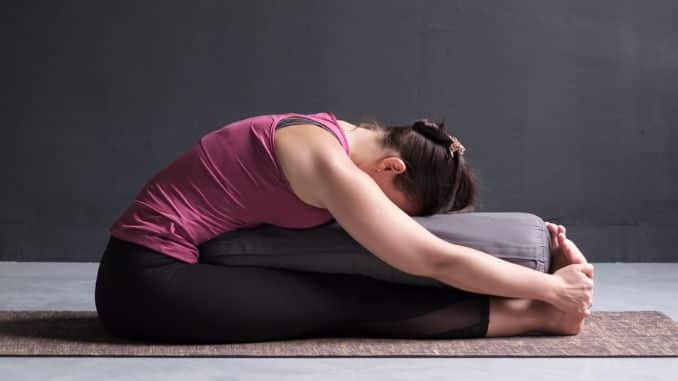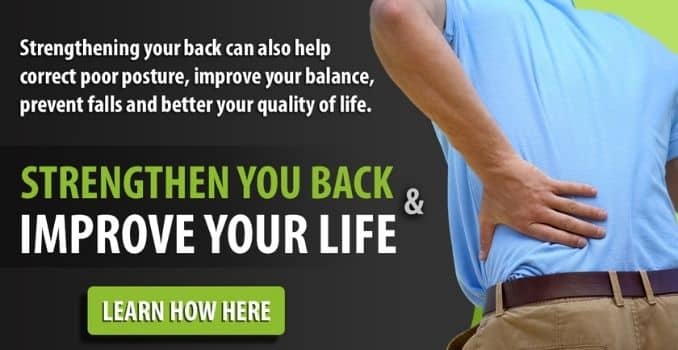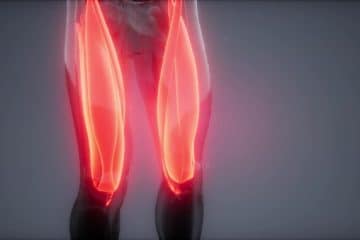If you spend long hours sitting at a desk, incorporating yoga Forward Folds into your routine can work wonders for your back. From head to heels, forward bending targets the muscles in your back, stretching them gently and promoting blood flow to the area. Not only do these exercises help alleviate pain and tension, but they also improve your posture and enhance your overall flexibility. In this post, we'll introduce you to the basics of Forward Folds Yoga Poses, highlighting their benefits and providing step-by-step instructions to help you perform them correctly.
How To Perform A Basic Forward Folds Yoga Poses?
- Begin Forward Folds Yoga Poses in an upright standing position. Your feet should be hip-width apart and your arms at your sides.
- Take a deep breath. As you exhale, slightly soften your knees.
- Begin to hinge forward from your hips, keeping your spine long and straight.
- As you bend forward, allow your hands to hang down toward the ground. You can either place your hands on the floor, grab onto your shins, or hold onto opposite elbows.
- Then, relax your neck and shoulders, and let your head hang heavy toward the ground.
- Breathe deeply and hold the pose for thirty seconds to one minute or longer if it feels comfortable.
- To come out of the Forward Folds Yoga Poses, engage your core and slowly roll up, one vertebra at a time, until you are standing straight again.
What Happens If We Fold Forward?
When we engage in Forward Bend yoga, such as touching our toes or reaching for our ankles, our body experiences several beneficial changes.
As you bend, you'll notice an immediate stretch in the back of your legs, specifically your hamstrings. These muscles, located on the backside of your thighs, tend to become tight due to factors like sitting for long periods or lack of regular stretching. The forward bend in the Forward Folds Yoga Poses certainly provides a gentle and effective way to lengthen and loosen those tight hamstrings, promoting flexibility and preventing discomfort.
Moreover, as you move deeper into the bend, you'll feel a lovely stretch along your spine. The forward folding motion creates space between the vertebrae, which can help alleviate any built-up tension or tightness in the back. It's a fantastic way to counteract the effects of prolonged sitting or standing, as it encourages a healthier posture and helps to relieve lower back pain.
And as we fold forward, there's an increased oxygen supply and blood flow to our brain, promoting mental clarity and rejuvenation. This movement often creates a sense of calmness and relaxation, allowing us to release any built-up anxiety.
The Importance Of Forward Bend For Your Back
This pose is crucial in maintaining a healthy back and overall body flexibility. They involve bending forward from the hips and lengthening the spine, which stretches the erector spinal muscles, hamstrings, and calves.
The importance of forward bends in Forward Folds Yoga Poses for your back can be seen in the following benefits:
-
Spinal Health
Forward bend helps to decompress and lengthen the spine, releasing tension and improving spinal mobility. This can provide relief from lower back pain and promote a healthy posture.
Example: In seated forward bends, where you reach toward your feet while seated on the ground, can help stretch the entire back and relieve tension in the spine.
-
Hamstring Flexibility
Tight hamstrings can contribute to lower back pain and limit overall mobility. Forward bends target the hamstrings, stretching and lengthening them over time. Increased hamstring flexibility helps to alleviate strain on the back and improve overall movement.
Example: If you bend forward from a standing position and reach towards the ground, it effectively stretches the hamstrings and helps in loosening the lower back muscles.
-
Stress Relief
Forward bends have a calming effect on the nervous system and can help reduce stress and anxiety. As you bend, you may experience a release of tension in your body and mind, promoting relaxation and a sense of peace.
Example: A seated forward fold with a relaxed neck and shoulders can help release tension from the upper body and induce a sense of calmness.
-
Improved Posture
Regular practice of forward bends can help improve your posture by strengthening the muscles that support the spine. It also encourages proper alignment of the spine and reduces the risk of developing poor posture habits.
Example: A standing forward bend focusing on engaging the core muscles can help strengthen the back muscles, leading to better posture and spinal alignment.
-
Increased Blood Circulation
Forward bends stimulate blood circulation to the head, neck, and spine. This increased blood flow nourishes the muscles, discs, and nerves in the back, promoting their health and functionality.
Example: Standing forward folds can be modified to include a gentle sway from side to side, which helps increase blood flow to the back and improve circulation.
Forward Folds
Forward fold is a cooling pose. It indeed helps with headaches (a good circulation for your brain).
To experience and maximize these benefits, here are a few variations to do Forward Folds Yoga Poses:
1. Seated Forward Fold
For this exercise, use a yoga block, bolster, or pillow to support your lower body in a forward position.
Begin in an upright sitting position on the yoga block with your legs extended in front of your body and your toes pointing upward. Then, place a bolster under your knees and above your thighs for support, maintaining good alignment with your head, shoulders, and hips. Afterward, Contract your core. Hinge through your hips to bend your upper body forward towards the bolster, relaxing your shoulders as you let your head hang heavy. Then, hold this position for several deep belly breaths, in through your nose and out through your mouth. Lastly, relax and return to the starting position.

Seated Forward Fold
To intensify the stretch, bend your knees and fold forward without support.
2. Half Standing Forward Fold
For this exercise, use a chair, bench, or any stable, elevated surface that can hold your body weight.
Firstly, begin this Forward Folds Yoga Poses in an upright standing position in front of a chair. Secondly, bend through the hips, and place your hands on the sides of the chair for support. Thirdly, move your feet back to increase the angle of your body. Then, drop your head through your arms, maintaining good alignment with your head, shoulders, and hips. Lastly, hold this position for several deep belly breaths, in through your nose and out through your mouth.
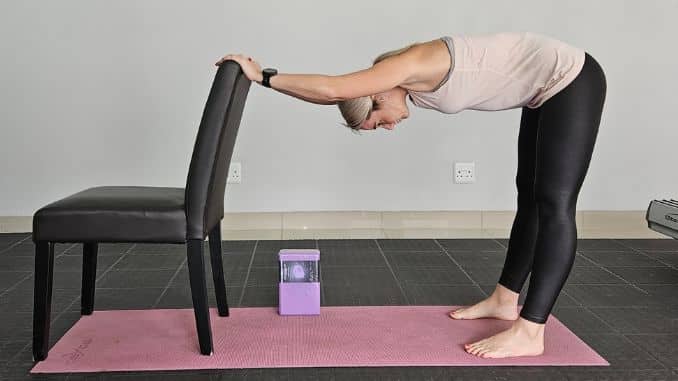
Half Standing Forward Fold
3. Exercise Variation
For this exercise, use yoga blocks, the bottom step of your stairs or any elevated surface to support your hands if needed.
Begin in an upright standing position with your legs hip-width apart, maintaining good alignment with your head, shoulders, hips, and legs. Then, tighten your core and hinge through your hips to bend your upper body forward. Slowly drop your head and rest your hands on the blocks while keeping your knees soft. Afterward, hold this position for several deep belly breaths, in through your nose and out through your mouth. Finally, relax and return to an upright standing position.
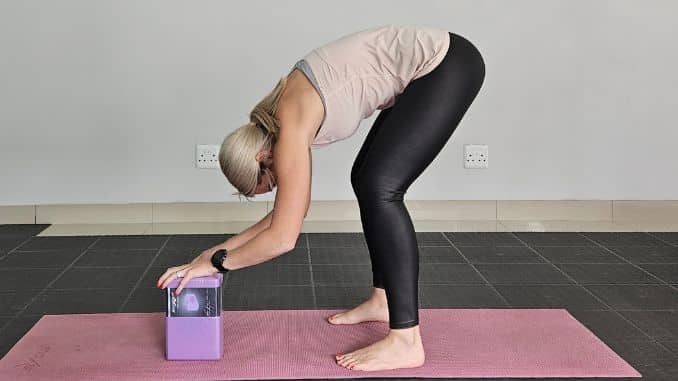
Variation Exercise
To intensify the stretch, clasp your hands behind your head.
Incorporating Forward Folds Without Support Into A Comprehensive Back-Strengthening Routine
1. Standing Forward Fold
Begin in an upright standing position with your feet hip-width apart, maintaining good alignment with your head, shoulders, hips, and legs. Then, tighten your core and hinge through your hips to bend your upper body forward. Slowly lower your head and arms to the floor while keeping your knees soft. You can also either shake or sway your upper body from side to side. Hold this position for several deep belly breaths, in through your nose and out through your mouth. Lastly, relax and raise back up to the starting position.
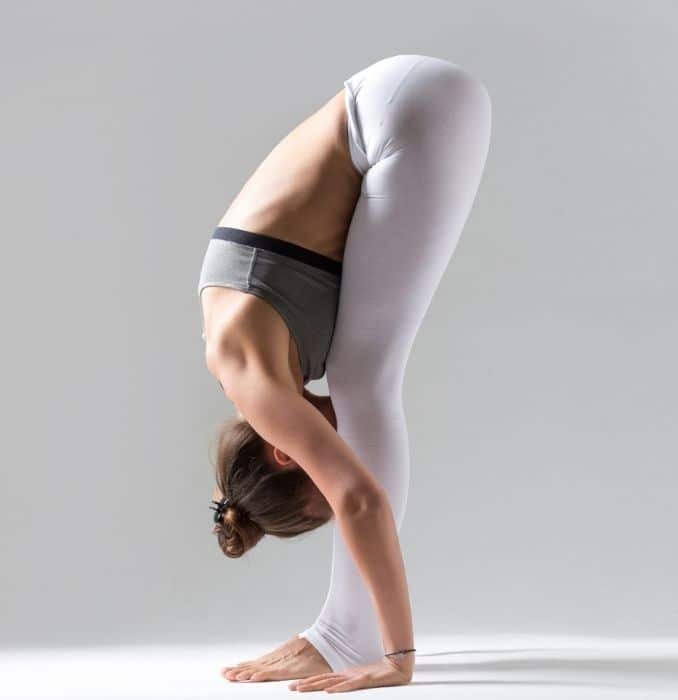
2. Seated Forward Fold
Begin in an upright sitting position, maintaining good alignment with your head, shoulders, and hips. Then, extend both legs in front of your body with your toes pointing upward. Afterward, contract your core, then hinge through your hips to bend your upper body forward, reaching for your toes with both hands. Lastly, hold this position for several deep belly breaths, in through your nose and out through your mouth. Relax and repeat the movement as needed.

Tips For Maintaining Proper Form And Avoiding Injury During Practice
Maintaining proper form and avoiding injury during forward bends is crucial to ensure a safe and effective practice. Here are some tips to help you achieve this:
-
Warm-up And Cool Down
Before starting and after any exercise routine, it is essential to warm up the body to prevent injuries and cool down to prevent muscle soreness and injury. Perform gentle stretches or a few rounds of Sun Salutations to prepare your body for a deep forward fold.
-
Engage Your Core
Activating your core muscles helps to stabilize your spine and protect your lower back. Drawing your belly button towards your spine creates a strong foundation for the forward fold.
-
Bend From The Hips
When folding forward, hinge from the hips rather than rounding your back. This forward fold technique certainly helps to maintain the natural curve of your spine, preventing strain on the discs and ligaments.
-
Lengthen Your Spine
Instead of collapsing into the fold, focus on lengthening your spine throughout the movement. Imagine a string pulling the crown of your head forward, creating space between each vertebra.
-
Modify As Needed
It's essential to listen to your body and modify the forward fold if you feel discomfort or pain. Use props like blocks or straps to support yourself and gradually increase the depth of the fold over time.
-
Relax Your Neck And Shoulders
Allow your neck and shoulders to relax in the forward fold, avoiding unnecessary tension. If needed, gently nod your head or rock it from side to side to release tension in the neck.
-
Breathe Deeply
Deep breathing relaxes your body and deepens your stretch. Inhale deeply as you lengthen your spine, and exhale as you fold forward, allowing your body to release any tension and go deeper into the stretch.
The Role Of Breathwork In Enhancing The Benefits Of Forward Folds
Breathwork plays a crucial role in enhancing the benefits of forward bends in yoga or any other form of exercise.
Common breathwork techniques in yoga pose:
1. Deep Belly Breathing Or Diaphragmatic Breathing
This technique involves inhaling deeply through the nose, allowing the breath to fill the belly, and exhaling fully through the nose or mouth. Deep belly breathing during forward bends helps to create a sense of spaciousness and ease in the body. As we inhale deeply, the breath expands the rib cage and lifts the spine, allowing for a greater stretch in the back muscles. This increases expansion and helps release tension in the hamstrings and calves, allowing for a deeper fold. By exhaling fully, we can release any tightness or resistance in the muscles, enhancing the stretch and promoting a sense of surrender.
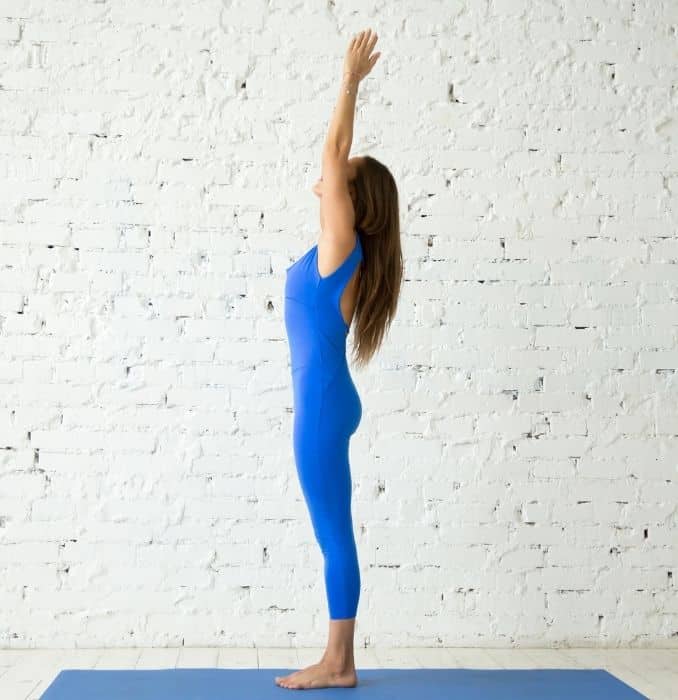
2. Ujjayi Breathing (The Ocean Breath Or Victorious Breath)
Ujjayi breathing involves constricting the back of the throat slightly, creating a subtle audible sound during both inhalation and exhalation. This technique helps to regulate the breath and brings focus to the mind, allowing for a more meditative experience during forward bends.
When practicing ujjayi breathing during forward bends, the sound of the breath can serve as an anchor, keeping the mind present and connected to the body. By maintaining a steady and even breath, we can sustain the depth of the pose and stay in the pose for longer, increasing the benefits of the stretch. The audible sound of ujjayi breath also has a calming effect on the nervous system, promoting a sense of tranquility and grounding.
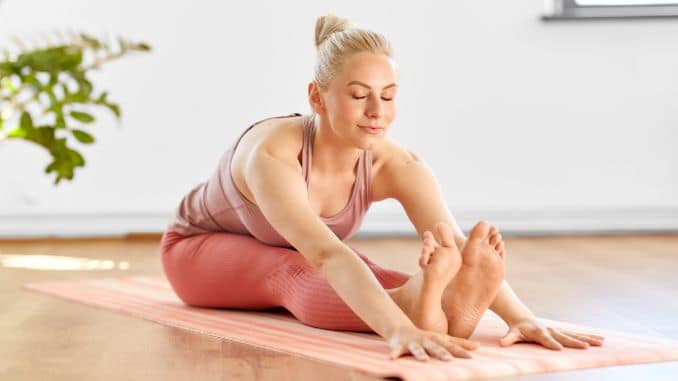
To illustrate the impact of breathwork in enhancing the benefits of this pose, let's take the example of Standing Forward Bends. Without incorporating specific breathing techniques, one might bend forward from the waist, relying solely on gravity to create the stretch. However, by applying breathing techniques, the practitioner can deepen the stretch, release muscular tension, and experience a greater sense of relaxation and focus.
Precautions And Contraindications For Forward Folding
When it comes to forward bending, it is important to take certain precautions and be aware of any contraindications to ensure a safe and effective practice.
Here are some precautions and contraindications to keep in mind:
-
Back And Neck Injuries
Individuals with existing back or neck injuries should perform this pose with caution. You may need to modify the pose or avoid it altogether to prevent further strain or discomfort.
-
Hamstring Flexibility
The range of motion can be impacted by tight hamstrings in a forward bend, increasing the risk of strain or injury. Practicing regularly and gradually increasing flexibility over time is essential to avoid overstretching the muscles.
-
Pregnancy
Pregnant women should take extra precautions when performing this pose. As the body undergoes significant changes, the ligaments become more flexible, increasing the risk of overstretching. It is best to consult with a prenatal yoga instructor or healthcare provider for modifications and proper guidance.
-
High Blood Pressure
The pose can increase blood pressure, especially when the head is below the heart. Individuals with hypertension or high blood pressure should consult with their healthcare provider before attempting a pose like this or practicing modified versions that do not involve extreme forward bending.
People with herniated discs or sciatica should be cautious as these forward bend yoga poses can pressure the affected area and exacerbate symptoms. Modified variations that provide support or avoid excessive flexion may be more suitable.
-
Breathing Difficulties
Individuals with respiratory conditions like asthma, aside from medications and asthma diets, should exercise caution during forward folds. These poses can put pressure on the chest and restrict breathing. Practicing with a qualified instructor who can guide proper breathing techniques and modifications is recommended.
It is important to listen to your body and never push beyond your limits. Suppose you experience pain, discomfort, or any unusual sensations, it is best to stop and seek guidance from a professional. Each individual's body is unique, and it is crucial to honor its limitations and capabilities to have a safe and enjoyable practice.
Example:
Let's say someone has a history of lower back pain and wants to practice forward folds. They should be cautious and consult with a healthcare professional or a qualified yoga instructor who can guide them on proper alignment, modifications, and the appropriate level of intensity for their specific condition. They may need to bend their knees slightly or use props like blocks or straps to support their practice and protect the lower back from unnecessary strain.
It's important to remember that forward bending should be practiced with proper alignment and awareness of your body's limitations.
Conclusion
Incorporating forward folds into your daily routine can work wonders for your back and overall well-being. By stretching and lengthening the muscles of your back, hamstrings, and calves, you can release tension, improve flexibility, and find relief from back pain.
Remember, listen to your body and honor the sensations you experience during each pose. As you gradually deepen your practice, you'll notice increased flexibility and a greater sense of ease in your back.
Moreover, as you gracefully bend forward, imagine yourself letting go of stress, worries, and any negative energy accumulated in your body. Embrace the rejuvenating power of these poses and allow them to nourish your mind, body, and soul.
Having a strong back allows you to perform daily tasks with ease and more importantly, prevent future injuries. Strengthening your back can also help correct poor posture, improve your balance, prevent falls, and better your quality of life. Don’t wait any longer. It’s time to focus on your back health! Check out our 10 Easy Movements For A Stronger Back!

